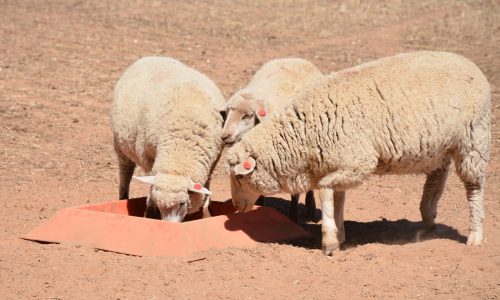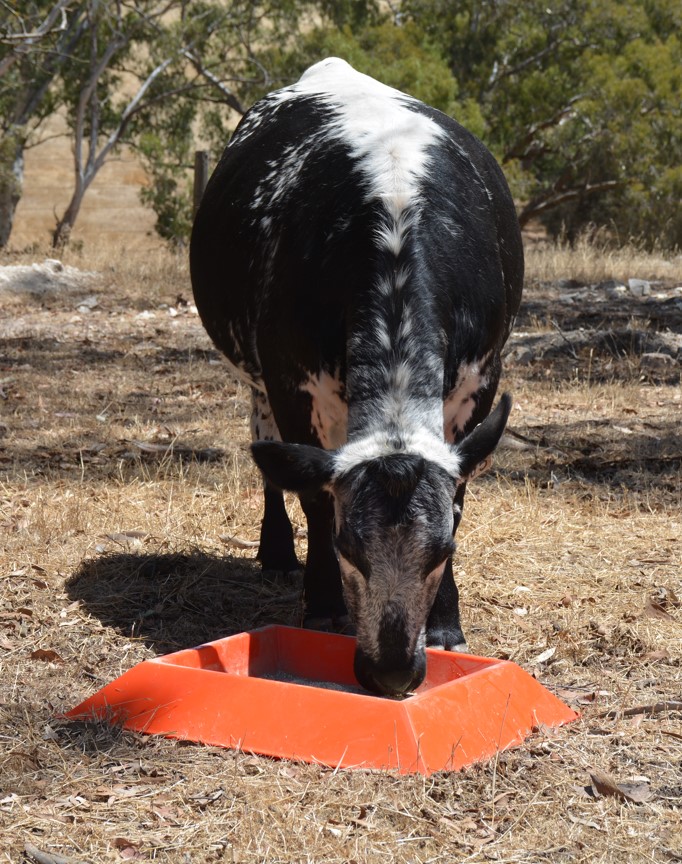How to use loose mineral licks from Alltech Lienert Australia
- Alltech Lienert Supplamins and Blueprint loose lick range are granulated, weather resistant and salt-based.
- Loose licks can be provided in a variety of containers (e.g. Troughs, tyre feeder, cut down drums, old guttering). Containers should be staked or secured so they can’t be tipped over easily.
- Holes should be drilled in containers (or bungs left off troughs) to allow water to run off the product, although it is weather resistant it should not be sitting in water.
- Containers should be located on the animal’s path to water, without being directly near the water.
- Loose licks should be offered to animals on an ad-lib basis.

Alltech Lienert loose lick intake guidelines
Allow one feed point for every 50 head of sheep and one feed point for every 25 head of cattle. Initial intakes may exceed feeding recommendations for a short period until stock reach required mineral levels. Intakes may vary due to individual animal requirements, seasonal conditions and pasture type, quality and availability.
Feeding Recommendations | |
Sheep: | 15g-30g per head per day |
Lambs: | 8g-30g per head per day |
Beef: | 50g-100g per head per day |
Beef Cows: | 100g-125g per head per day |
Weaner Cattle: | 40g-80g per head per day |
Frequently Asked Questions
When should I use a loose lick?
Loose lick can be used all year round when grazing green or dry feed. Some farmers will choose to provide loose lick in times of peak demand, such as joining, pregnancy, lactation, weaning and growth. Alltech Lienert has a variety of loose licks tailor-made for these times.
Why use a loose lick?
Loose lick intakes are lower than lick blocks, as animals consume 100% nutrients with each lick. Lick blocks contain non-nutritious carriers to hold their shape and therefore higher intakes are required to consume their daily requirements. Generally, animals with access to a lick block will not consume enough as they don’t lick for long enough; they may get bored or bullied away by other animals.
How can I train my animals to use a loose lick?
If animals have not used a loose lick you can use an attractant such as lucerne hay/chaff or grain around the container for a few days to get them near the area. Once animals have tried the product they should continue to consume their daily allowance.
Animals are consuming more lick than expected
Higher intakes can occur in the initial introduction period. Keep topping up the container to ensure loose lick is always available. Higher intakes can be due to mineral deficiencies in the animal, but they should drop back to daily intake levels overtime. If the loose lick is too close to the water source, this can also cause higher intakes, if so, move the container further away from the water source after the introduction period.
Why does the loose lick look coloured?
Alltech Lienert loose licks have a natural dye added to visually distinguish between the products for quality and traceability.
What is in the loose licks?
Alltech Lienert loose licks for sheep and cattle contain a variety of macro and micro minerals and vitamins A, D3, E & B1, designed for maximum absorption, better growth, health and performance
- The Blueprint range (gold standard) contains 100% organic (chelated) trace minerals, proven to maintain immune status and reproductive health.
- The Supplamins range (standard) contains a blend of organic (chelated) and inorganic trace minerals.
View the product guides below to find out the best loose lick product for your animal’s needs or contact us here.

